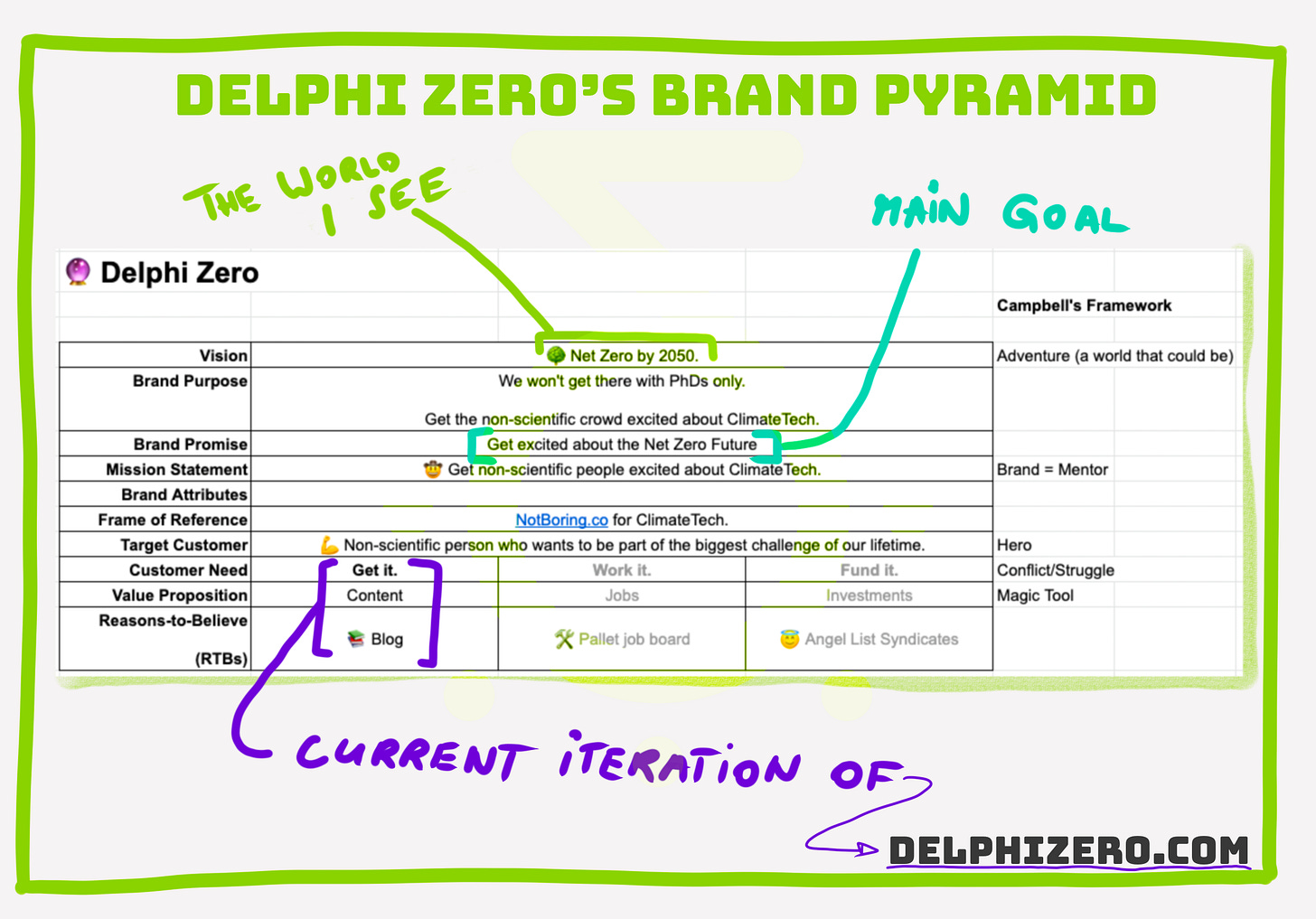Keeping the Climate Tech Promise
How to communicate the why, what, how of your climate tech project.
👋 Howdy to our 40 new readers! Now, we are 212 climate-curious friends.
Keeping the Climate Tech Promise
By Art Lapinsch
Hi friends,
It’s time to talk about a topic dear and near to my heart: Story Telling 📖
To tackle challenges like climate change we have to collaborate. The deciding factor is whether people care, understand, and know how to act towards a shared goal. This week’s essay will be a super tactical deep-dive into the Brand Pyramid framework as well as a behind-the-scenes view of how I think tell stories at Delphi Zero.
I hope that after this essay, you’ll walk away with a new superpower.
With a Great Story Comes Great Responsibility
Our superpower as a species is that we are able to collaborate and coordinate. But unlike the algorithmic execution of ant colonies, our collaboration is rooted in shared ideas.
If you break down an organization into its constituent parts you are left with ordinary people. Each person has their own needs and ways of living. But how do we get everyone to work towards a common goal?
The simplest way I can explain this is by using the analogy of arrows. Imagine you are a brave lord and your goal is to save your land from an evil force. The evil force lives in a fortress. To overthrow the evil force, your archers have to fire arrows at the fortress.
Ideally, everyone is pointing in the same direction before they fire. If they do, they hit the target. If not, then they don’t.
Congratulations, you just learned the first lesson of management: Alignment.
The human condition makes us believe that all the good stuff is because of us while all negative outcomes are someone else’s fault. Hence, if teams don’t hit their targets, managers say something along these lines:
But let’s be real: We have the power to do something about it. The most powerful tool in the arsenal of a leader is a good ol’ story.
Let’s learn how to use it.
Stories Are Guidebooks 📗
Stevie J. - the founder of some kind of fruit company once said that "the most powerful person in the world is the storyteller. The storyteller sets the vision, values, and agenda of an entire generation..."
Is this quote overused? Definitely. Is it still helpful? You bet!
I like it because it summarizes the true impact of stories and allows us to isolate the three core pillars of great narratives:
Why (Vision) → Save our land from the evil force 😈 → Makes people care.
What (Agenda) → Take the fortress 🏰 → Makes people understand.
How (Values) → Fire arrows at the fortress 🏹 → Makes people act.
Once a story is out in the wild it replaces the storyteller. The true power of good stories is that it gives power to the people to act on their own. They know why, what, and how.
Of Promises and Pyramids
Many moons ago, I used to work in the world of glossy magazines and brand advertising. The question we would debate endlessly was: What is a brand?
A brand is a promise that you keep over and over again.
From where I stand now, I can tell with confidence that a brand is essentially a story:
Promise = Why & What
Over and Over = How
The single most helpful framework I know is the Brand Pyramid. We used it to align brands of all sizes ranging from personal brands to multi-national companies.
I’ll show you how you can apply it.
Why Pyramids
If you’re an aficionado of architecture, then you’d know that pyramids are those silly structures with a fat bottom and a pointy top. Literally speaking and figuratively speaking you are totally right. I want to focus on the latter.
Pyramids as a framework offer us a structure where we have a single element at the top supported by increasing layers of smaller elements. The bottom supports the top.
It is vertical alignment done right. Let me show you.
The Power of Clarity and Consistency
I’ll explain the Brand Pyramid by looking at Silicon Valley’s darling: Stripe
Stripe is a financial technology company. They are celebrated as one of the companies with the clearest communication across their website and all products.
In 2020, I conducted a brand audit of Stripe and filled in all fields in my Brand Pyramid template. This is how it looked 👇
Vision: Stripe believes that in the future the online economy will be larger than the offline economy ⛳️
Purpose: Stripe is working to increase the GDP of the internet to align with the vision 👆
Promise: Stripe is building the payments infrastructure for the internet to align with the purpose 👆
For the sake of simplicity, I am omitting the middle sections of the Brand Pyramid.
Value Proposition: Stripe organizes their value into product categories so that it aligns with all of the above 👆
Reasons-to-Believe (RTBs): Stripe builds products to align with the value proposition categories 👆
The vision is “the why” → Makes people care.
The purpose and promise are “the what” → Makes people understand.
The value prop and the RTBs are “the how” → Makes people act.
Fast forward to today, I did a fresh brand audit of Stripe’s website to see if they are still aligned with their promises from 2020. Look at their website in 2022 👇
Vision (online economy > offline economy) and promise (payments infrastructure for the internet) are still the same ✅
Value proposition (payments; business operations) and RTBs (products) are largely the same ✅
I hope you can see by now how such a structure can help you keep your promises over and over again. Everyone from customers to employees knows what they are about. This is why Stripe is considered to be one of the best brands out in the wild.
Now let’s apply what we learned back in Climate Tech 🌳
Articulating the Promise of Climate Tech
A couple of weeks ago, I argued that Climate Tech is unprecedented in a variety of ways:
A noble mission of saving the planet before it’s too late 🌍
The largest entrepreneurial opportunity in history 🚀
The most inspiring and well-intentioned journey group 🙌
Climate tech doesn’t have an opportunity problem. It has a story problem.
The fundamentals are great, yet people don’t understand them enough to care. This is where a good ol’ story can help.
I’ll show you how I used the Brand Pyramid when I started the Delphi Zero project back in May 👇
Vision: Net Zero by 2050
Since I didn’t know much about the industry yet, I picked a North Star that was aligned with many other players in the market: Net Zero by 2050.
The good thing about Net Zero is that one can also start imagining a world around it:
28 years from now 🏙
Abundant energy ☀️
No net carbon emissions 🌳
This world is still a far cry from where we have to go (i.e. 350ppm) if we want to have the good old days back but at least it is tangible. It helped me to write the first Delphi Zero essay and set the tone for all upcoming pieces. The result was a piece called “Prologue: House of Day Zero” where I imagined a museum in the future that would teach people about humanity’s journey to Net Zero.
Purpose: The Narrative for the Non-Scientific Crowd
I would say the purpose of Delphi Zero crystallized a bit more over the past weeks.
Initially, my purpose was the same as my promise of “getting the non-scientific crowd excited about Climate Tech” but it didn’t fully capture “the what”.
What would I do? Would I dance? Would I consult? Would I build?
At the end of the day, I write. That’s my what.
This is how it’s explained on the homepage:
Promise: Get Excited About the Net Zero Future
After I identified (a) what I would do I had to summarize (b) what my audience would get out of it.
The big problem from my perspective was similar to what I had outlined further above:
Climate tech doesn’t have an opportunity problem. It has a story problem.
The fundamentals are great, yet people don’t understand them enough to care. This is where a good ol’ story can help.
The promise I try to keep to myself and to my audience is to write entertaining long-form content to get people excited about climate tech.
Instead of “Bio-Engineering 101” I framed it as “Fermentation Is Eating the World” → Background story about brewing beer.
Instead of “3 Reasons Why Climate Tech Is a Hot Industry in 2022” I framed it as “Climate Tech: The Greatest Game” → Background story about childhood games.
I work with stories because they (1) make people care, (2) make people understand, and (3) make people act.
Value Proposition: Content
I’m standing on the shoulders of giants.
People like Tim from Waitbutwhy, Packy from Not Boring, and Andrea from Snaxshot are my heroes. They’ve done it successfully for other topics and I’m taking my own shot at climate tech.
The idea is to write the best climate long-form for the non-scientific crowd.
The goal: Get people excited about climate tech.
Less stick, more carrot
My role-models are@waitbutwhy@packym and@iiiitsandrea They are masters of curation, synthesis, and optimism.
Reasons-to-Believe (RTBs): Delphizero.com
I’m keeping my promise (i.e. getting people excited about climate tech) by publishing long-form essays on a weekly basis. They have a similar tone of voice and a similar look and feel 👇
At this point, I’d like to give a massive shoutout to Sara and Chris for listening to my half-baked ideas, Finn for helping me with the brand alignment of Delphi Zero, and Nate for teaching me the tools to have a kick-ass visual identity. There are so many more.
Thank you! It would be impossible to do this on my own.
Zooming Out: Keeping the Climate Tech Promise
The beautiful thing with the Brand Pyramid is that it allows me to tell my climate tech stories.
It’s the same brand across all touch points. My readers know what I’m about and more importantly: I know what I’m about. It helps me to remain consistent over and over again.
What works for a one-person project like Delphi Zero works as well for organizations of all sizes where many people need to be working together. Remember the arrows pointing all in the right direction?
As a leader of a group or as the chief of your own destiny, you have to ask yourself: What is the story I want to tell?
Once you know the why, what, and how, the Brand Pyramid will help to keep your promise over and over again.
🙏 Thanks, Deanna, Sydney, Ben C., Kevin, Ben B., Dimitry, Ian, and Parker for discussing and editing.
As always, if you want to reach out to me, just reply via mail or ping me on Twitter.
Damn, slowly but surely this newsletter seems to take a steeper growth trajectory. If you joined since the last essay, please let me know how I can help you.
If you enjoyed this essay, please consider sharing some love in whatever way feels good to you.
If you hated this essay, please tell me, and let’s chat.
Thanks, y’all 🙏
Art
This essay was originally published on Delphi Zero.
















Thanks Art! I love your definition of branding and the pyramid, quite helpful!
I wonder if we really need to get people excited though! How does excitement solve the climate emergency? Perhaps the answer will come to me as I read more of your posts... :)